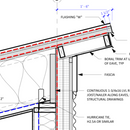Wind-driven rain at shed roof ridge
I am unable to determine if there are recommendations for how to ensure that a ridge vent (in this case a shed roof ridge) is less vulnerable to wind driven rain. I have a secondary WRB which will protect the roof, so I guess I could avoid worrying about it. In general, does wind driven rain go UP? Are there general recommendations regarding opening orientation, flashing overlaps, etc?
GBA Detail Library
A collection of one thousand construction details organized by climate and house part










Replies
I have seen this profile from PAC CLAD: https://sweets.construction.com/swts_content_files/2216/644249.pdf
It seems somewhat clunky and less applicable in an application that has an overhang at the ridge.
Ethan,
There are a few variants on the ridge vent you linked to in your second post. The most common one is to use a typical L-shaped ridge-flashing for a shed roof, and provide vented closure-strips between each rib.
I wouldn't usually worry about the location of your vent, except you have the vertical surface of the thickened overhang right behind it. Wind blown rain might hit it and splash up. Another solution might be to move the vent down to the lower Boral soffit where it is better protected.
Ethan,
Your original detail looks OK to me. I wouldn't worry. In the rare event of water entry, evaporation will dry everything out.
Ethan, you asked if wind driven rain can go up. It certainly can, but that usually only happens regularly in high-wind locations, especially near a bluff. In those cases it's best to use an unvented roof assembly, or to design a more elaborate venting detail. But if you're in a more typical location, you shouldn't have to worry.